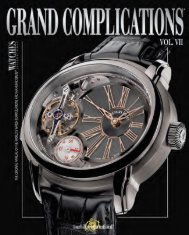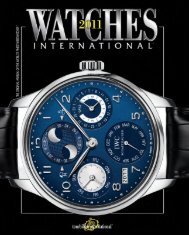180 YEARS OF
180 YEARS OF
180 YEARS OF
Create successful ePaper yourself
Turn your PDF publications into a flip-book with our unique Google optimized e-Paper software.
1958<br />
Focus<br />
on Power<br />
Reserve<br />
CONQUEST<br />
Even 30 years after the debut of<br />
the first self-winding wristwatches,<br />
many potential customers<br />
were still skeptical about<br />
them. Manufacturers sought to<br />
dispel their skepticism by equipping<br />
watches with power-reserve<br />
displays. Longines, too, added<br />
this useful indicator to its newly<br />
developed 290 family of movements.<br />
Self-winding Caliber 290,<br />
which was first used in the Conquest<br />
family of watches, was 26<br />
millimeters in diameter and had<br />
24 functional jewels, a direct central<br />
seconds hand and a Glucydur<br />
balance that completed<br />
19,800 semi-oscillations per<br />
hour. The special feature of sixmm-thick<br />
Caliber 294 was that its<br />
power-reserve display had a centrally<br />
positioned disk onto which<br />
a hand was printed (see illustration).<br />
A central rotor wound the<br />
mainspring in both its directions<br />
of rotation via a ratchet wheel<br />
changer. If the watch was worn<br />
regularly, it would amass a 45hour<br />
power reserve, the level of<br />
which was shown on the indicator.<br />
Unlike base Caliber 290, Calibers<br />
291, 292, 293, and 294 each<br />
had a date display at 12 o’clock.<br />
e Milestones | WATCH HISTORY<br />
1960<br />
New<br />
Movement<br />
Family<br />
CALIBER 340<br />
Longines oered three top lines of automatic<br />
watches: Admiral, Conquest and<br />
Flagship. e brand-new 340 family of<br />
calibers debuted in the very slim Flagship<br />
in 1960. Its distinction lay in an ocenter,<br />
ball-borne, heavy metal rotor with<br />
a complete wreath of teeth. A patented<br />
satellite wheel changer tightened the<br />
mainspring for bidirectional winding.<br />
Longines integrated the automatic module<br />
into the 4.45-mm-thick movement.<br />
e Glucydur ring balance vibrated at a<br />
pace of 19,800 semi-oscillations each<br />
hour. Calibers 340, 341, 342, 343 and 345<br />
each had a directly propelled central<br />
seconds hand; minor technical improvements<br />
were incorporated into versions<br />
342, 343 and 345. Calibers 350, 351, 352,<br />
353 and 355 did not have seconds hands.<br />
A date display in a window distinguished<br />
versions 341, 343, 345, 351, 353 and 355.<br />
e base movement (Caliber 340) had<br />
243 components, which were manufactured<br />
by machine in a 960-step process.<br />
is family of calibers was used in the<br />
very classical Flagship line in 1960.<br />
LONGINES SPECIAL WatchTime | 81

















